A story about one of the most commonly used tools for applying paints. Varieties of painting rollers and their characteristics on Finnish classification.
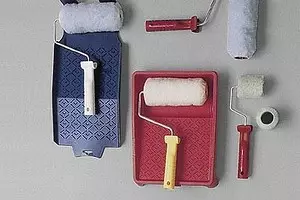
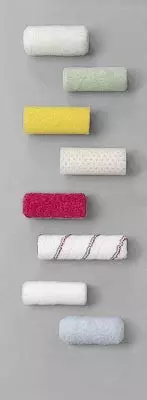
Banner
Elon
Porous foamflast
Penflast perforated
Polyester
Peron.
Diena
Polyar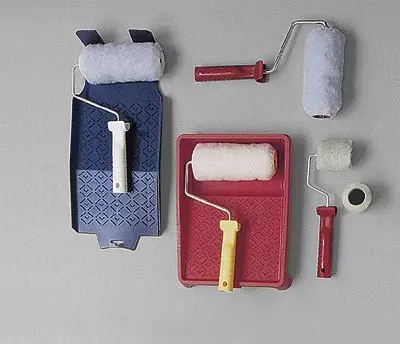
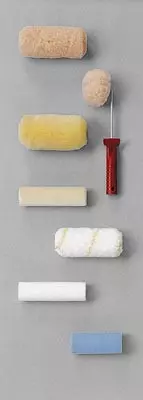
Rilon
Rilon
Sheepskin
Mocher with a short pile
Terry fabric
Felt
Porolon
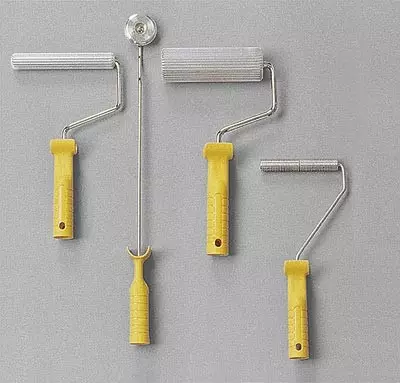
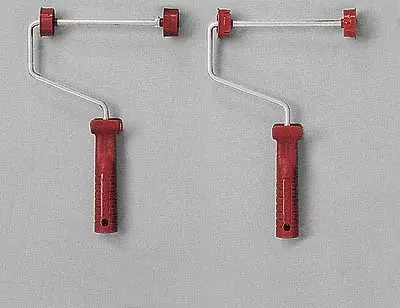
| Type of roller | Material fur coat | Moching size, mm | Type of paintwork | Place of application and features | ||||||
|---|---|---|---|---|---|---|---|---|---|---|
| L. | D. | D. | Length Vors. | Water distribution | Alkyd, oily | Nitrocellulose | Polyurethane, epoxy | |||
| MINI | Re (Polyester) Porolan (Molletopren) | 55. | 35. | fifteen | 10 | +. | +/- | - | - | Have a rounded side, which avoids a thick layer of paint at the edge. Designed for small work on smooth surfaces and for decorative works |
| 60. | 35. | fifteen | 10 | +. | +/- | - | - | |||
| 70. | 35. | fifteen | 10 | +. | +/- | - | - | |||
| 100 | 35. | fifteen | 10 | +. | +/- | - | - | |||
| 110. | 35. | fifteen | 10 | +. | +/- | - | - | |||
| 150. | 35. | fifteen | 10 | +. | +/- | - | - | |||
| 160. | 35. | fifteen | 10 | +. | +/- | - | - | |||
| RA (Polyamide) Perfekta Perfekta | 100 | 40. | fifteen | 12 | +. | +. | +. | +. | For all types of LKM. Have a long service life and ensure uniform paint in half of the coarse surfaces. | |
| 150. | 40. | fifteen | 12 | +. | +. | +. | +. | |||
| 100 | 40. | fifteen | 13 | +. | +. | +. | +. | |||
| 150. | 40. | fifteen | 13 | +. | +. | +. | +. | |||
| RS (Polyacryl) Kanekaron Modacryl (Kanecaron Philce) | 100 | thirty | fifteen | eight | +. | +. | +. | +. | For all types of LKM, including two-component. Used on smooth and harsh surfaces | |
| 150. | thirty | fifteen | eight | +. | +. | +. | +. | |||
| 100 | 24. | fifteen | four | +. | +. | +. | +. | |||
| 150. | 24. | fifteen | four | +. | +. | +. | +. | |||
| N (natural materials) velor | 100 | 24. | fifteen | four | +. | +/- | - | - | For high-quality lescing and finishing color of smooth surfaces with acrylic paints and varnishes | |
| 150. | ||||||||||
| Mohair | 100 | 24. | fifteen | four | +. | +/- | - | - | For the finishing color of smooth surfaces with water latex and acrylic paints | |
| 150. | ||||||||||
| MIDI | Re (Polyester) Porolan (Moltopren) | 160. | fifty | 33. | 10 | +. | +/- | - | - | For small work on smooth surfaces and for decorative works |
| West | 100 | 57. | 33. | 12 | +. | +. | +/- | +/- | Cheap rollers for work on a small smooth and half-haired surfaces | |
| 150. | ||||||||||
| Ra (polyamide) peron | 100 | 57. | 33. | 12 | +. | +. | +. | +. | For all types of LKMs by half-sighted surfaces | |
| 150. | ||||||||||
| Perfekta. | 100 | 60. | 33. | 13 | +. | +. | +. | +. | ||
| 150. | ||||||||||
| PC (Polyacryl) Kanecaron | 100 | fifty | 33. | eight | +. | +. | +. | +. | For all types of LKM, including two-component on smooth and half-mixed surfaces | |
| 150. | ||||||||||
| Modakril (Kanecaron-Filtz) | 100 | 40. | 33. | four | +. | +. | +. | +. | ||
| 150. | ||||||||||
| N (natural materials) velor | 100 | 40. | 33. | four | +. | +. | +/- | +/- | For finishing painting on smooth surfaces with water latex and acrylic paints | |
| 150. | ||||||||||
| Universal and professional | Re (polyester) | 140. | For rough, semi-stroke and smooth large surfaces. Inexpensive | |||||||
| West | 180. | 90. | 47. | 20-22. | +. | +. | +/- | +/- | ||
| 200. | ||||||||||
| 240. | ||||||||||
| Yellow West | 200. | 90. | 47. | 20-22. | +. | +. | +/- | +/- | Have reinforced fiber, more durable. Optimally suitable for internal works | |
| 250. | ||||||||||
| 270. | ||||||||||
| PC (Polyacryl) | 200. | 90. | 47. | twenty | +. | +. | +. | +. | For all types of LKM. Have a long service life, optimal for semi-dry surfaces, but fit for smooth and coarse surfaces | |
| 250. | ||||||||||
| 270. | ||||||||||
| Ra (polyamide) | 200. | 90. | 47. | twenty | +. | +. | +. | +. | For all types of LKM, very durable, in all types of surfaces, for coarse and rough, it is better to use nylon, having a particularly durable fiber | |
| Peron. | 250. | |||||||||
| Perfekta Nylon | 270. | |||||||||
| N (Natural Materials) Sheepskin or Lama Fur | 200. | 90-100 | 47. | 20-30 | +. | - | - | - | For high quality uniform coatings. Expensive | |
| 250. | ||||||||||
| 270. | ||||||||||
| Facade | Re (polyester) | 200. | 95. | 56. | twenty | +. | +/- | - | - | The best option for water dispersive facade coatings. Designed for large areas |
| Yellow West | 250. | 100 | 62. | twenty | +. | +/- | - | - | ||
| 270. | 100 | 62. | twenty | +. | ||||||
| PC (Polyacryl) | 200. | 95. | 56. | twenty | +. | +. | +. | +. | Are suitable for all types of LKM, have a long service life, differ in quality (see color) | |
| 250. | 100 | 62. | twenty | +. | +. | +. | +. | |||
| 270. | 100 | 62. | twenty | +. | +. | +. | +. | |||
| Ra (polyamide) | 200. | 95. | 56. | twenty | +. | +. | +. | +. | Have a long service life. | |
| Peron. | 250. | 100 | 62. | twenty | +. | +. | +. | +. | You can use on any types of surfaces and any LKM. It is better to use nylon rollers on rough and rough surfaces | |
| Perfekta Nylon | 270. | 100 | 62. | twenty | +. | +. | +. | +. | ||
| Special for the floor | Ra (polyamide) peron | 500. | 70. | fifty | 12 | +. | +. | +. | +. | For coarse and rough surfaces, for all types of LKM |
| N (natural material) mohair | 500. | 60. | 40. | 12 | +. | +/- | - | - | For smooth and smooth surfaces | |
| Special for wavy surfaces | Ra (polyamide) peron | 150. | 100 | 60. | 22. | +. | +. | +. | +. | Special roller for painting asbetic sheets or professional flooring, for all types of LKM |
Painting the walls, floors, ceilings and other elements of the house or apartment can be different paints and different tools. One of the most popular and common-consuming tools for applying paints is a paint roller. About him and go a story.
Varieties of rollers There are many and each of them is intended for a completely defined type of work. The painting rollers differ not only by the scope of application, but in size and material coat.
A few words about the terms. The roller is called a part of the tool consisting of a cylinder (plastic, wooden or aluminum) with a soft coat, which absorbs the paint and then transfers it into the painted surface when rolling. A familiar design, consisting of a handle and a curved metal rod (BEULE), to which the roller is worn, is called a machine or just with a handle.
Now that we dealt with the terminology, let's talk about the classification of rollers. Domestic painting rollers are divided into four groups (GOST-10831-87 "Paint rollers. Specifications") and each of them has its letter marking: the first letter is always in (roller), the second is determined by the material from which its fur coat is made, and Third, if it is, is the scope. So, the first three groups are intended for painting surfaces with paintwork: a frame of a fur coating, the second-ripped rims with a fur coating for the coloration of the floors, the third-mixtures with a fur coating for the color of concave angles. The latter, the fourth flooring with polyurethane foam (foam) coating to work with water-adhesive compositions. According to GOST, the fur coating of the painting roller should be made from sheepskin or a silk basis covered with a pile of chemical threads.
Recently, a huge number of various imported rollers appeared on sale. Their range is so great that it makes even think of a specialist thinking. Different countries use their classifications of rollers. For example, Finnish manufacturers share rollers at 7groups.
Mini rollers Mostly used for coloring small or hard-to-reach surfaces, including corners. Midi Valiki - One of the most common types of amateur painhers. Difference between Universal and Professional The rollers are very conditional. The criterion of this division, as a rule, is the quality of the fur coat and the diameter of the rod. For professional instruments, a higher quality of the fur coat is characterized (they are much slower than wearing) and the diameter of the 8mm rod. Facade rollers It characterizes the presence of internal intermediate packing and a more advanced bearings. Due to this, in combination with an increased diameter, when working with such a tool, the roller turns slowly and the resulting paint splashing is sharply reduced.
Frame rollers Very comfortable in work, as it is easily enveloped. In addition, they are 20-35% cheaper than traditional rollers. The peculiarity of these rollers is already indicated in their name - the coat is not put on a cylinder from any material, like all other designs, but on a special frame from wire or polymer. Hospital, they are still little known in Russia.
Special rollers They are divided into rollers for gender, wavy surfaces, aggressive and structural compositions, lamination and for tuning wallpaper.
But one of the leading tool manufacturers for painting works by Anza (Sweden) uses another classification. In size, these are three groups: mini, mussel and maxi-rollers, and for use - five groups: high-quality Perfekta; for all types of repair (floors, walls, ceilings); for varnishes and enamels when a very smooth surface of the coating is required; Special and simple work.
In addition to the size of the painting tool, it is necessary to pay attention to the material from which its fur coat is made. Here the situation is even more complicated, because for the designation of approximately alone and the same materials of the fur coat, different firms use their specific names. Here are the main groups of materials for the fur coat and some of their names used by Sokeva (Finland):
Polyester group (Polyester): Porolan (Molletoprene), Vestin (artificial fur), Yellow Vestin (reinforced);
Group N-Natural materials: Sheep fur, Lama, goats, velor, mohair, felt, rubber;
PC-polyacryl group: Kanekaron, Modacryl (Kanecaron-Filt), Meryl;
Group of rainamide: pon, nylon.
Even the fur coats made of one material may differ among themselves to other parameters. Here are just a few examples. Mini-rollers are made of several types of foam rubber: normal and highly discovered with a density of 30 and 60 kg / m3, respectively. Naturally, a denser roller serves longer. Poropolone mini-rollers used for high-quality painting with varnishes and water paints are produced in two colors: dark blue (top quality) and thick yellow. Polyacryl rollers from the material called the melir, imitating the fur of the lamb, are produced in three colors (the okay of quality increase): blue, yellow and light green, and pocket rollers (polyamide) are white, light yellow and light green.
| Type of roller | Length of the fur coat (L), mm | Moft diameter (D), mm | The diameter of the planting hole (D), mm |
|---|---|---|---|
| Mini rollers (small) | 50-150 | - | fifteen |
| Midi rollers (medium) | 50-150 | - | 33. |
| Universal | 150-270. | 52-90. | 44-50 |
| Professional | 150-270. | 52-90. | 44-50 |
| Facade | 150-270. | 80-105 | 44-62. |
| Frames | 180, 250, 270 | 55-90. | 38 (40), 47 |
| Special | 100-500 | 36-80 | 15-60 |
Choosing a roller, except for the material of the coat itself, you need to pay attention to its compatibility with the lack-colorful material you are going to use. The coat capacity of the coat to the effects of paint can be judged by the stripes applied to it, the more stable the material to aggressive substances. In addition, on strips, it is possible to determine the method of its manufacture and replacement. If the strips on the fur coat go along the roller, it means that it is sewn and can be replaced. If they are located across or macaw, then the coat is glued and it is impossible to replace it. Most fur coats for mini and midi rollex-glued. They are not too durable, as paints and varnish materials quickly destroy glue. Rollers with glued fur coats are relatively cheap, because the process of their manufacture is less laborious. The fur coats to professional, versatile, facade and special rollers are usually stitched. They serve longer and, if necessary, be replaced with new ones.
And so that you feel easier to navigate when choosing a roller, you can use the data of our table in which the fur coat material and permissible types of paints and varnishes are correlated. The most resistant to the effect of chemicals fur coat from polyamides and polyacryls, they can be used almost for all frequently used paints and varnishes. It is more complicated by the situation with polyesters, they are suitable only for water-emulsion, alkyd and oil paints. Not for all kinds of paints are suitable for coats from natural materials. The price of the roller ranges from $ 1,5do $ 12-15, depending on the size, material and quality.
Finally, a few words about the so-called textured rollers (to create textured surfaces). They are produced quite a lot of varieties, each of which is designed for a certain type of work with textured (textural) finishing materials. Syryposochye, you can roll the drawing on the prepared surface, get a coating for marble or "wild" stone and many other options.
In order not to be mistaken as an acquired tool for painting works, focus on the presence of an international quality certificate ISO9001.
Some tips beginner malar
Do not strive to use a very large sized roller immediately, it is rather difficult for them to work, it is difficult to achieve uniform staining of the surface.
In order for the surface to be stained smoothly and without flips, the roller should be well rolled over a special pallet before applying paint on the wall, and if it is not, then on the leaf of perforated metal or, in extreme cases, cardboard is either plywood. Then the roller will remain so many paints as needed.
If you want to use a roller to apply different color paints than the one that applied to it, thoroughly ride it on a sheet of cardboard or plywood until you make sure that the spots of the previous color disappeared. Then go to the color of the surfaces.
Do not use the same roller to apply different types of paints, even if the roller was wellhed with the corresponding solvent.
If you need to protect the roller from drying for several days, then carefully pack it into a whole polyethylene package and tighten it tightly.
If you need long-term storage of roller (for several months), place it in a cans, suitable in length and diameter, pour paint and wrap everything into a polyethylene package.
And in conclusion, it is still necessary to say about the machines (handles) for rollers (the price is $ 1.5-15). They differ not only in the size of the Burel, but also just for the total length. There are short (approximately 30cm), medium (40-45 cm) and long (more than 50 cm) machines. If you need to paint something very high, then for these purposes special extension handles are produced. The length of such handles varies from 0.7 to 4m ($ 25-45).
There are several other items that are designed to make work with a roller more comfortable and high-quality. More often on sale you can meet pallets ($ 0.8-2), sets consisting of a roller with a pallet ($ 3-6), roller stands ($ 1.5-2) and scrapers ($ 0.3) for His cleaning. Vadodone provides a place where the paint is poured, and the surface at which the roller can be pre-rolled to achieve its uniform impregnation.
So before starting to paint, pick up a suitable roller, get a paint pallet and other necessary accessories, and then work will give you pleasure.
